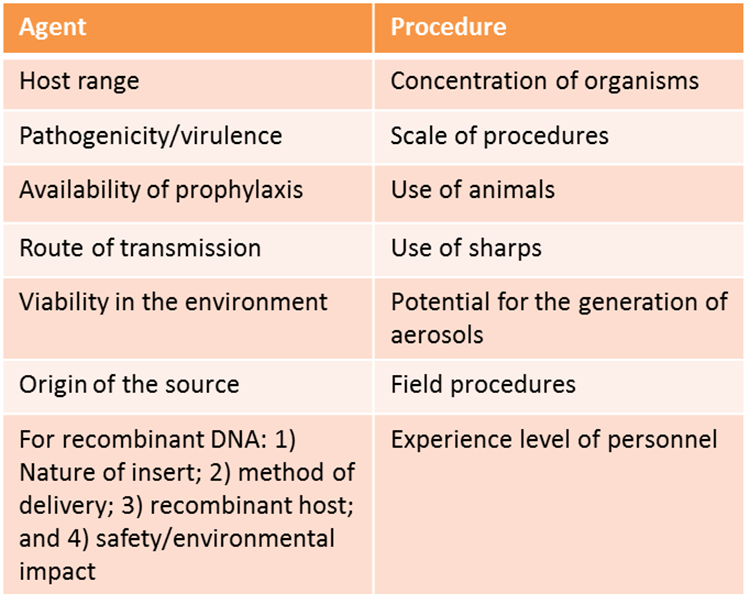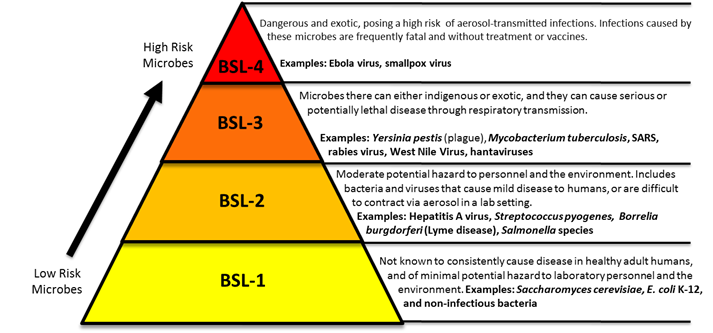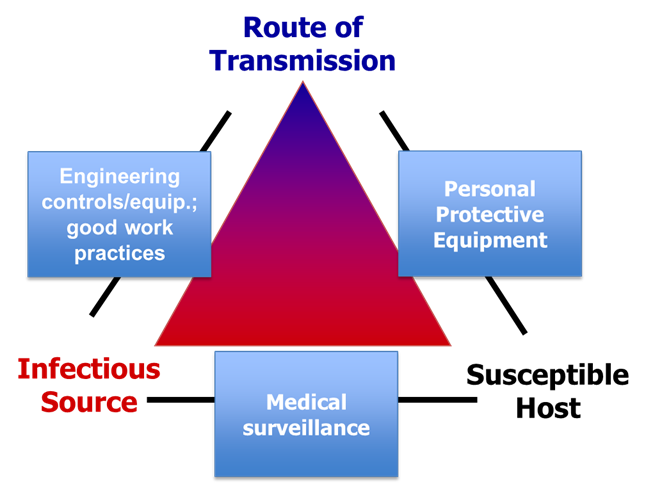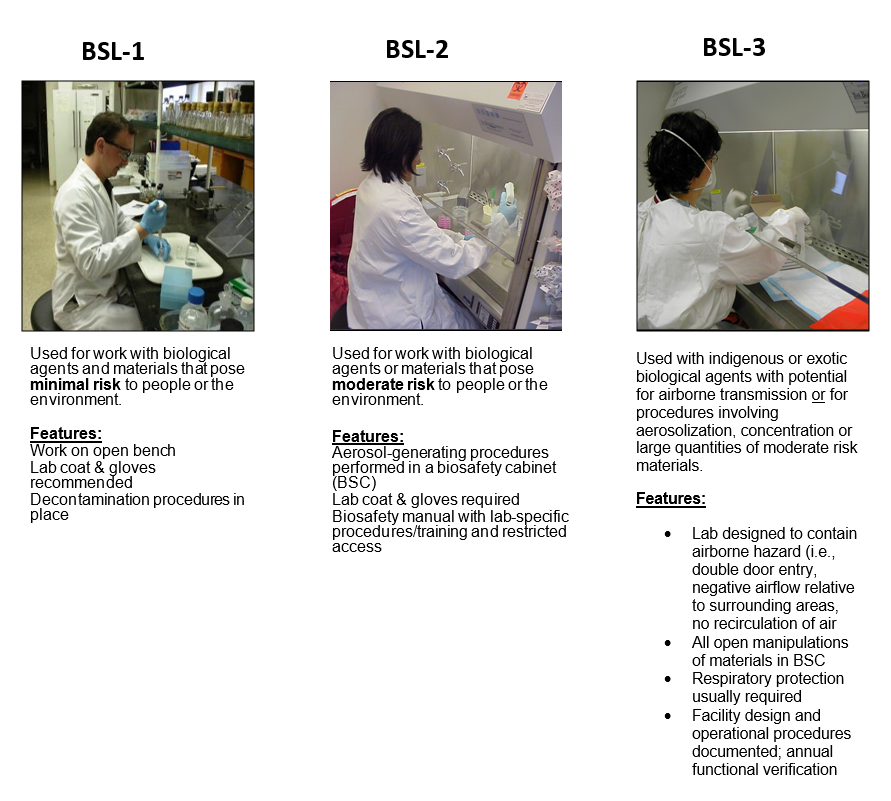2.1 Biohazard Awareness and Risk Assessment
Biological laboratories are special work environments that can pose infectious disease or toxin exposure risks to persons working or entering these laboratories. In fact, there is a clear historical record of infections having been acquired in laboratory settings. More than 4,000 laboratory-acquired infections (LAIs) have been reported since the 1920s and many others have likely occurred. Some LAIs have been associated with morbidity & mortality, expensive remediation costs, and/or damaging publicity.
There may be instances where agent or procedural characteristics create unique hazards such as the potential for aerosolization of pathogens cultured in concentrations higher than found in nature, inadvertent contamination of surfaces, etc. Given the microscopic nature of most biological hazards, it is difficult-to-impossible to directly evaluate the risk in real time. Consequently, only ~15% of all LAIs are attributable to a known or identifiable accident or exposure. Therefore, understanding the potential risks and proactive/preventative measures to mitigate those risks is essential.
This section outlines the biosafety principles related to risk assessment, agent risk groups, and prevention paradigms (biosafety levels).
Biological hazards are any agents, materials, or conditions that pose a threat to human, animal, plant, or environmental health.
Biological hazards include the following:
- Biological agents, including bacteria, viruses, fungi, protozoa, helminths, and prions. These are also referred to as infectious agents, etiological agents or pathogens. Biological agents are propagative, cause a broad range of diseases (asymptomatic-to-fatal), and may take hours-to-years to manifest as disease in the host.
- Recombinant or synthetic nucleic acid molecules. While nucleic acids do not pose an explicit risk, the macromolecules they encode (or interact with) and resulting phenotypes may. Recombinant or synthetic constructs that encode toxins, viruses, oncogenes, antibiotic resistance (of clinical relevance), or any other molecule that contributes to disease are of particular concern. Host cells/systems, method/control of gene expression, potential for horizontal/vertical transfer, and/or research procedures may contribute to the risk of recombinant/synthetic nucleic acid molecules.
- Biological toxins, venoms or other molecules derived from biological systems that may cause or contribute to disease. These are non-propagative, but often have acute and serious-to-fatal effects.
- Blood, blood products, tissues, secretions, excretions, or cell lines derived from humans or animals. The risk profile is generally: human > primate/simian > other mammals > avian > reptile/amphibian > arthropods (other invertebrates)
- Novel nanoparticles conjugated to biologically active or cell-modifying molecules (e.g. siRNA, antibodies, effector proteins, etc.).
- Environmental specimens, particularly plant, soil, or water samples that are likely reservoirs of high-risk biological agents or toxins.
One of the unfortunate consequences of working with biological hazards is the potential for acquiring an infection. History has shown that such infections occur and that laboratory workers are clearly at higher risk for infection with certain agents, such as the hepatitis B virus, than the general population.
Although work-related infections can occur via routes that differ from those in naturally occurring disease, there are limited routes of exposure and modes of entry into the body. A worker exposed to an infectious aerosol could inhale respirable particles. Larger droplets of that aerosol could fall on skin, mucous membranes, or environmental surfaces. The worker could then inadvertently inhale or ingest the agent without experiencing an overt accident. On the other hand, a needle stick or an animal bite would usually be noticed. Providing awareness and barriers for these routes of infection is a preventative approach to biosafety. The following are the primary routes of transmission that can result in laboratory acquired infections.
- Injection (percutaneous)
- Contaminated sharp objects (e.g. needle, scalpel)
- Animal bites, scratches
- Through broken or abraded skin (including rashes, eczema, split cuticles, etc.)
- Absorption (mucous membrane contact)

- Splashes to the eyes, nose, mouth
- Hand to face movements (i.e., applying cosmetics, cell phone usage, etc.)
- Ingestion
- Eating/drinking
- Applying cosmetics
- Contact with tear ducts
- Inhalation (aerosols)
- Liquid disturbance
- Syringe preparation
- Dried animal excretions
- Leakage from injection site
In addition to the biohazard and route of transmission, host factors play an important role in the outcome of an exposure/infection. Factors that can increase susceptibility include:
- Underlying diseases, particularly those affecting the immune system
- Age (children and elderly are at higher risk)
- Treatment with antimicrobials, steriods, or anticancer drugs
- Vaccination status
- Type of pathogen/agent exposure
- Opportunistic pathogens can cause disease only when introduced into an unusual location or an immunocompromised host (e.g. normal flora, most environmental yeasts/molds, etc.).
- A primary pathogen (also known as true or frank pathogen) can cause disease in an otherwise healthy individual (e.g. Staphylococcus aureus, Streptococcus pyogenes, hepatitis B virus, influenza virus, etc.).
A thorough biological risk assessment determines the proper safety and containment precautions given the intrinsic risk of the biohazard(s), procedures, and health of laboratory workers.
The risk assessment is a guide for the selection of appropriate controls and microbiological practices, safety equipment, and facility safeguards. The risk assessment will be used to alert others to the hazards of working in the lab and to the need for developing proficiency in the use of safe practices and containment equipment. Successful control of hazards in the laboratory also protects persons not directly associated with the laboratory, such as other occupants in the building, infrequent visitors (e.g., facilities services), and the public.
Risk assessments generally begin with the question, “Is the biological material that I’m working with capable of causing human disease or environmental harm?” If so, the PI should work with the BSO to determine the best safety practices and level of containment to reduce the chance of accidental exposure or release of infectious agents, recombinant agents/organisms, or other relevant biohazard. If you are unsure, contact the Biosafety Office for guidance.
Basic considerations for the risk assessment are listed it the table below:
Infectious agents are grouped according to their intrinsic biological properties, particularly their pathogenicity and virulence in humans. Similar principles are used to categorize the risk of recombinant materials, which could impact human (or animal or plant) health and/or the environment if released.
Risk groups consider the following:
- Pathogenicity of the organism
- Virulence of the organism
- Mode of transmission and host range
- Availability of effective preventive measures (e.g., vaccines)
- Availability of effective treatment (e.g., antibiotics, antivirals)
- For recombinant materials: type/pathogenicity of host, gene/transgene products, gene expression, targeted effects (and consideration of off-target effects), phenotypes, biological/environmental impacts
Risk groups range from 1-4, with RG1 posing minimal risk to healthy individuals and public health and RG 4 posing a very serious risks to individuals and public. The Biosafety Office follows the World Health Organization’s (WHO) Laboratory Biosafety Manual, 3rd ed., NIH Guidelines, and BMBL categorization of risk groups as follows:
- RG1 – Are rarely associated with disease in healthy adult humans or animals and pose no-to-little public health risk (e.g. Saccharomyces cerevisiae, E. coli K-12 strain derivatives often used for recombinant/molecular biology, many environmental organisms).
- RG2 – Are associated with mild to moderate disease for which preventative measures or post exposure treatments are often available; public health impact is limited (e.g. Streptococcus pyogenes, Salmonella , hepatitis B virus)
- RG3 – Are associated with serious to lethal human disease for which preventative vaccines or post exposure therapies may be Public health impact is limited-to-moderate (e.g. Mycobacterium tuberculosis, hantaviruses, West Nile virus)
- RG4 – Are associated with serious to lethal human disease for which preventative vaccines or post exposure therapies are not Public health impact is high (e.g. Ebola virus, Marburg virus, smallpox virus, etc.).
RG4 agents are not permitted at UTK!
Once the RG and other procedural factors are determined, basic considerations for risk reduction include:
Risk awareness
- Risk assessments are performed and communicated
- Materials and procedures are reviewed by the IBC as required
- Containment recommendations are implemented
- Standard Operating Procedures (SOPs) are developed and communicated
Control of materials
- Containment requirements per the risk assessment are followed
- Materials are labeled and securely stored per risk assessment
- Biohazard inventory is documented, maintained and controlled
- Secondary containment is used for storage and transport of biohazards
Good Practices
- Follow prescribed personal & lab hygiene principles, also known as Standard Microbiological Practices (SMP; see Module 4 for details)
- Wear and maintain personal protective equipment (PPE) per the risk assessment and manufacturers recommendations
- Communicate hazards via door placard, biohazard labels, etc.
- Segregate and dispose biohazardous wastes per Biosafety Office guidelines
- Decontamination must be routine and effective based on the risk assessment and prudent practices
- Communicate and follow emergency response procedures (spills, personal exposures, injuries, etc.)
Restriction of Access
- Follow prescribed laboratory security procedures per institutional policy
- Secure storage equipment in common areas and placard with content owners name and contact information
Biosafety Levels (BSL) prescribe procedures and levels of containment for the particular microorganism or material (including research involving recombinant or synthetic nucleic acid molecules) and associated procedures. In addition to the risk reduction strategies highlighted above, BSLs also consider primary barriers (e.g. biosafety cabinets), secondary barriers, facility design, air handling, laboratory security, etc. BSLs are graded from 1 – 4; as the BSL increases so does the relative risk of the agent/procedures as well the stringency of procedures and facility design. Generally, these correlate with RGs (e.g. a RG2 agent is worked with at BSL-2), but there are exceptions (e.g. production volumes, high-risk procedures, etc.).
The majority of work at UTK involves Biosafety Level 1 & 2 practices.
Biosafety Levels: Breaking the Chain
Another way to think about biosafety levels is that they are a systematic approach to disrupting the chain of infection (or release). By disrupting or eliminating the pathways between an infectious source and a susceptible host (or environment), safety, containment, and security can be assured. Examples are provided in the diagram below.
Biosafety Levels Permitted at UT
Resources that are helpful in determining risk group and biosafety levels include:
- Agent summary statements in the CDC/NIH document Biosafety in Microbiological and Biomedical Research Laboratories (BMBL).
- Appendix B Classification of Human Etiologic Agents on the Basis of Hazard from the NIH Guidelines.
- The OSHA Bloodborne Pathogen Standard interpretation letter regarding risk for all human cell lines (must be used at BSL-2).
- The American Biological Safety Association’s (ABSA) database of Risk Group Classification of Infectious Agents.
- The Public Health Agency of Canada’s PSDS for Infectious Substances.
- The World Health Organization (WHO).
- Research publications (various)
- This Biosafety Manual



